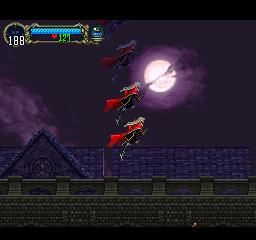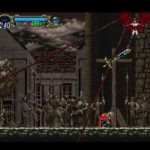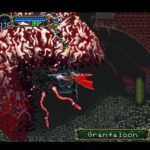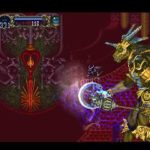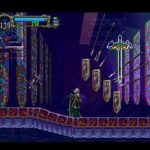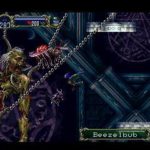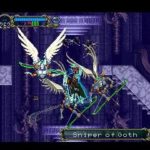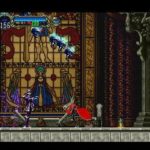Developer: KCET Publisher: Konami Released: October 2, 1997 Genre: Action/Adventure
Castlevania: Symphony of the Night is one of the greatest games of all time. Let’s get that out the way right now. In 1997 when everyone was creating 3d games, whether they had the skill or not, Konami took a chance and held to the series’ 2d roots. It was a bold move, but like Mega Man 8 and Mega Man X4 we as gamers reaped the benefit. Not only did it show that 2d was still viable it also created a template that the series would follow for years. This is a classic in every sense of the word.
Symphony of the Night is a direct sequel to Rondo of Blood and follows a few years after. As that game had never left Japan at the time it wisely begins with a playable recap of its final battle. Four years after these events Dracula’s castle reappears and Richter Belmont disappears. It is then that Alucard, son of Dracula awakens and returns to his father’s castle to put an end to his reign once and for all.
These days you can’t sneeze without tripping over a new “Metroidvania”. The indie game movement owes a great deal to Symphony of the Night and Super Metroid, leaving us with an embarrassment of riches. But in 1997 that wasn’t the case. There were very few games that tried to mimic the style of Metroid and the few that did were not very good. It is amazing how well Castlevania lends itself to this style and Konami deserves credit for not following the industry trends of the time. There is a reason Konami continues to re-release it to this day.
Alucard is a stark contrast to previous Castlevania protagonists. He moves with a level of grace seldom seen in video games and is a joy to control. The greater degree of control allows you to navigate the environment so easily it makes other games feel limited. Alucard has a number of moves right off the bat that expands significantly with progress. From the double jump to the various vampire forms new relics are introduced up to the game’s conclusion. There are even spells that use Street Fighter style button commands although they aren’t necessary.
Structurally the game is near identical to Super Metroid with a few differences. Super Metroid is full of large open fields as it is a planet full of distinct zones. Here each room is full of enemies as it takes place almost entirely within the castle. Even with that caveat the game still manages to exhibit a great deal of diversity within its environments. The castle is sensibly laid out with numerous warp points that make traversal a breeze. It doesn’t reach the masterful level of interconnectivity in Super Metroid but it comes close. Possibly the game’s greatest feat is its subtle guidance. You have total freedom from the onset and while you can sequence break there is somewhat of a set path. The game never explicitly guides you but provides enough of a nudge to keep you going.
Exploration is at the heart of the genre and Symphony of the Night always rewards your effort. No matter how small it is almost always worth it to revisit a small corner of the map previously undiscovered. Whether it’s a new piece of equipment, a relic, or just the experience gathered along the way you will always gain something for your effort. Honestly there are so many features and mechanics it is almost overwhelming. But the fact that you can ignore most of it with no penalty is part of why the game is so great.
Despite the genre shift the game hasn’t forgotten its roots. All of the subweapons return with a few new ones such as the Agunea, which fires lightning and the rebounding crystal. You still gain hearts and items from candles and there are a slew of returning bosses. That aspect of the series has not changed with Symphony boasting some of the series’ best encounters. Granfaloon is a giant mass of bodies protecting its core. As you hack away they fall by the dozen without a hint of slowdown. There are a number ripped from Rondo of Blood and Castlevania IV such as Slogra and the Minotaur. Sadly by the time you reach Dracula you are strong the fight isn’t memorable. I’ll take that over the hair pulling final battles of previous titles however.
If there are any criticisms you can make about Symphony of the Night it is that it is too easy. That is because the balance is so incredible; you will never have to grind for experience. You gain levels at a steady pace and any grinding is overkill. Save rooms are spread out evenly and refill health, not that you will need it much. Boss battles are simplified with the presence of overpowered subweapons like the Holy Water. Outside of a few outliers (Galamoth especially) most will have little trouble reaching the end. Especially if you do even a modicum of exploring and find some of the overpowered weapons and items.
The game is also short. The Metroidvania genre as a whole tends to be shorter than most titles. It works in their favor as there is little bloat and they end on a high note. On average I would say most will finish it in five or six hours. That is including the mid game surprise that effectively doubles the game’s length. You can go for 200% (yes, 200%!) but that will only make the game even shorter. Personally I think the game is the perfect length. But I’ll be damned if I didn’t want it to ever end.
In Closing
If the worst you can say about a game is that you want more than it is doing something right. The production values are some of the best on the platform, especially the soundtrack and the gameplay is sublime. Castlevania: Symphony of the Night defied all expectations and is not just one of the best PS One games of all time but one of the best games ever made. If you’ve read this far you need to buy it now, no questions asked.


